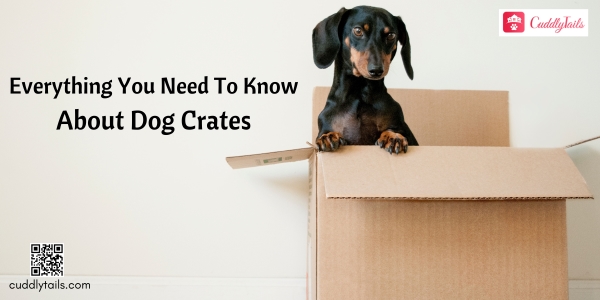Everything To Know About Dog Crates
Crates are safe and comfortable for our furry friends as they naturally like den-like spaces. From puppyhood to adulthood, the right crate could be your best friend and help you better care for your dog.
Uses of Dog Crate
- Resting Space – Your dog can sleep in the crate when you’re traveling, in a hotel, or at someone else’s house.
- Safety Space – You can keep your dog in the crate when you can’t supervise him. Your dog can also use the crate when he feels unsafe.
- Training Aid – Crates can be used for Potty training and curing separation anxiety.
- Vet Recommended – A vet might advise your dog to use a crate after surgery to aid recovery, etc.
Styles of Dog Crate
1. Plastic
Plastic crates are lightweight and easy to disassemble and reassemble, making them a good option for traveling. They are also easy to clean and covered on all sides like a den, making them the ideal choice for potty training. However, plastic crates might not have much airflow and can heat up quickly.
2. Wire
Wire crates are durable but heavy. They are also temperature-resistant, easy to clean, and have good airflow at the cost of exposure on the sides.
3. Wood
Style and the liberty to creatively design a crate for your pup comes with wooden crates. These crates are more like dens, durable, and can meet the house’s interior. However, wooden crates are heavy and not suitable for travel.
4. Canvas/Mesh
Crates made of canvas or mesh are lightweight and ideal for traveling as they can be assembled quickly. The downside is that these crates are hard to clean due to their fabric.
Size of Dog Crate
An ideal crate should be big enough for your dog to easily stand up, turn and lie down. A little more space than required is good and allows your dog to stretch but larger than that would lose its den-like structure and the sense of safety it provides.
For potty training, the crate shouldn’t be so big that your dog can relieve himself in one corner and then sleep in the other.
Suitable Crates for Different Dogs
- For Aggressive Chewers or Escapers – Wire or wood
- For Travel – Plastic or Mesh
- For Potty Training – Plastic or Wire
- For Anxious Dogs – Plastic, Wood, or Canvas
Where To Put The Crate
Keep the crate near you so you can attend to her needs as soon as possible. Also, the crate should be in a spot away from noises. In the daytime, you can keep the crate in the kitchen or living room. At nighttime, you can keep the crate in your bedroom.
Setting Up A Comfy Crate
Wire, canvas, and plastic crates come disassembled and you need to build them. For the assembly process, refer to the instruction manual that came with the crate. In case there is no manual, check the company’s website, email them or call them to learn the steps for assembling your crate.
After the crate is set up, you can decorate it and make it more comfortable and cozy for your pup by placing a soft bed, cushion, or blanket. You can also keep new or your dog’s old toys in the crate so he feels welcomed in this new space.
How To Properly Use A Dog Crate
- Never keep your dog for more than six hours inside the crate.
- Keep puppies for short time.
- Take your dog out to play, eat, drink, or potty at suitable times.
- Follow instructions thoroughly for collapsing or assembling the crate.
Have to go out for work and your dog’s not a fan of staying in the crate? Don’t fret. Just book a dog sitter with Cuddlytails and they will attend to your dog’s every need professionally and lovingly.
Visit www.cuddlytails.com for more information or download our Android or iOS app for more information.
Thank you,
The Cuddlytails Team

